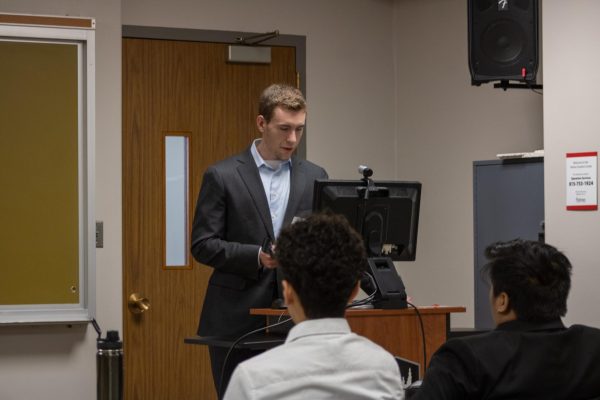Bench serves as resting place
November 22, 2004
Nestled between two large bushes and behind a twisted tree sits a worn, old bench.
Names and initials of forgotten couples are etched on its stone surface. Litter and cigarette butts clutter its base, and the wording across the front, “Fred L. Charles Memorial,” is now covered in a mossy green hue.
Located outside Swen Parson Hall, the bench’s bordering concrete is worn and broken. Visitors cannot read the end of “Member of original … “ because the last piece of concrete is missing.
This now-weary bench is not just a place to sit but a memorial to Fred Lemar Charles, one of the original faculty members who founded NIU.
The inscription around the border is supposed to read “Gift of Wife and Children … Member of Original Faculty NISTC … Teacher of Nature Study,” said Glen Gildemeister, director of the Regional History Center. NISTC refers to NIU’s original name, Northern Illinois State Teacher’s College.
These inscriptions highlight the major interest of Charles’ life.
“In my view, Charles was the third most important NIU figure of the entire first century,” Gildemeister said.
Charles was the first professor of nature study and biology and built the zoo and plant house behind Altgeld Hall. He also assembled and coached the first women’s basketball team in 1899 and established the Northern Star’s predecessor, The Northern Illinois.
Although Charles was quite well-known in his day, some do not know the purpose of the bench.
“I think I know it as the kissing bench,” said Dawn Sibley, a secretary in the department of geography, which is located in Davis Hall near the bench. The NIU bench known as “The Kissing Bench” actually is located closer to the East Lagoon.
“I have no clue what the memorial is for,” said Zach Farber, a freshman clinical lab science major. Farber often walks by the bench on the way to one of his classes.
The bench is appropriately settled around a lot of nature, one of Charles’ main interests. Birds are often near the bench, and it is amongst several trees and bushes.
“The only thing I notice about the bench is that squirrels run around on it,” Farber said.
Charles had a love for flowers and animals and spent much time in the science department. He was named chair of biology in 1899 and held that position until 1909, when he was called to the University of Illinois. At U of I, he was staffed as an assistant professor of agriculture.
Charles committed suicide in 1911, despite his success and popularity among students who knew him.
He had been in poor health for a long time due to a chronic illness and reportedly had been under nervous strain as well as suffering from chronic depression.
The day of his suicide, his wife went to his bedroom door, which was locked, and received no answer after knocking. She assumed he was asleep and let him be, for he had been having trouble sleeping for some time. Later that evening, she climbed through the window and discovered he had killed himself.
In honor of his memory, Charles’ widow created a memorial fund to provide science students with loans. In 1943, the family requested a bench be built with the remainder of the funds as a memorial to Charles.
Today, the bench is relatively unknown.
“I notice it, but I don’t know anything about it,” said Barb Voga, a secretary in the department of geography.
Charles’ passion and energy is preserved by the memorial.
“People who sit on that bench will never know how much they owe to the man whose name it bears, but that is the way of all education,” Gildemeister said. “We build on those who went before us and set foundations for those who will come here long after we are gone.”












